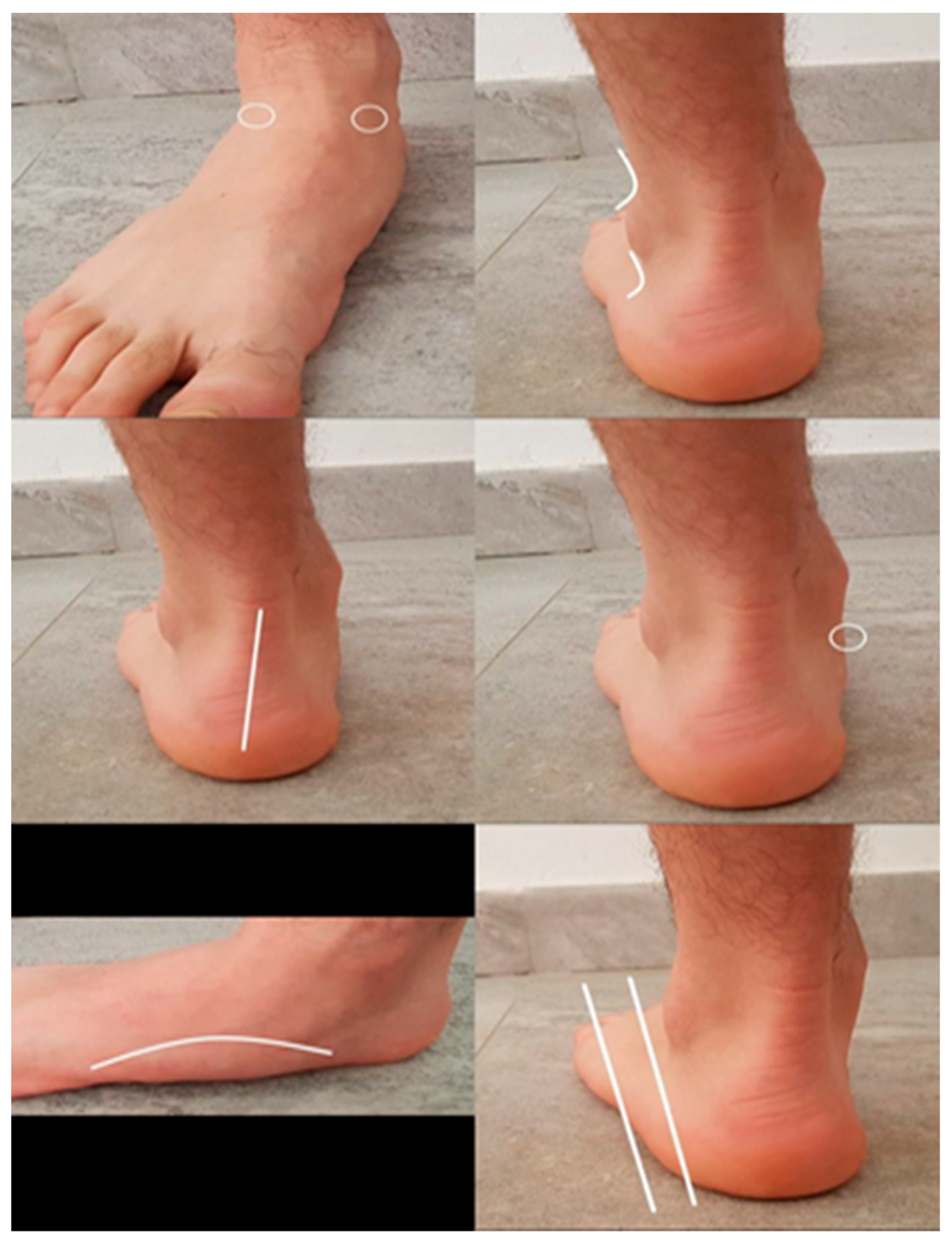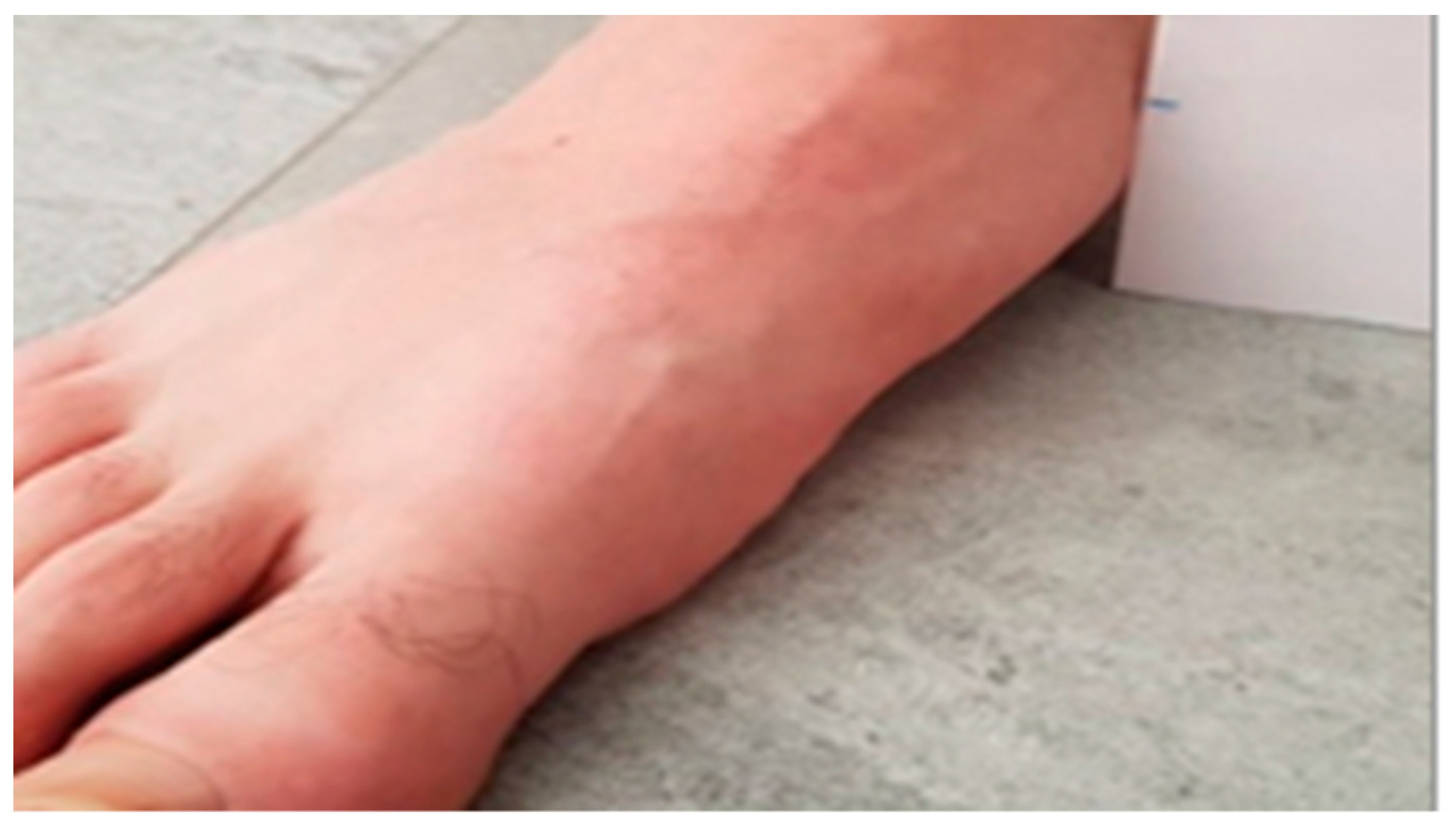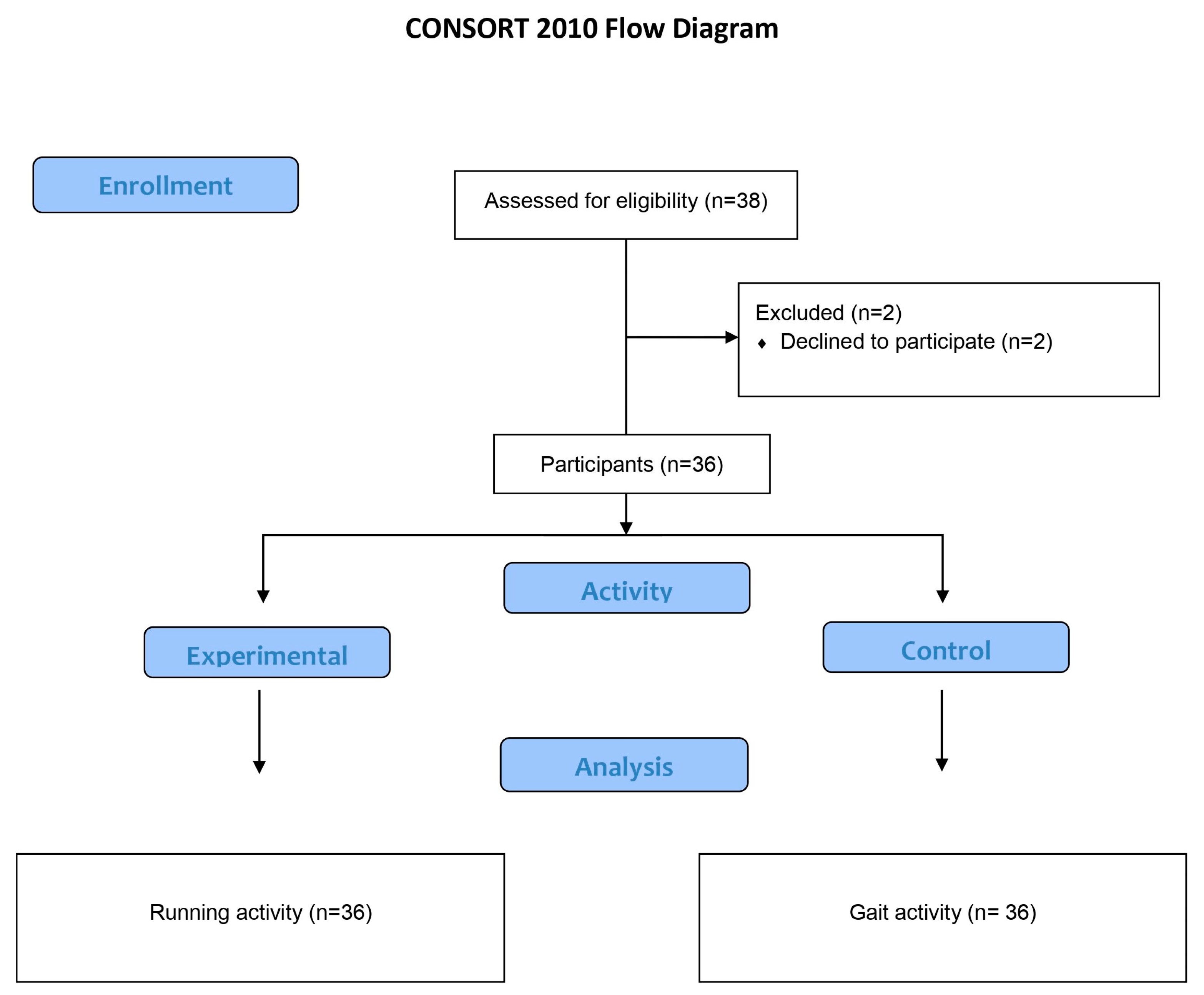A Short-Term Evaluation of Foot Pronation Tendency in Healthy Recreational Runners
Abstract
:1. Introduction
2. Materials and Methods
2.1. Participant Recruitment
2.2. Procedures
2.3. Statistical Analyses
3. Results
4. Discussion
5. Conclusions
Author Contributions
Funding
Institutional Review Board Statement
Informed Consent Statement
Data Availability Statement
Conflicts of Interest
References
- Xiang, L.; Gu, Y.; Wang, A.; Mei, Q.; Yu, P.; Shim, V.; Fernandez, J. Effect of foot pronation during distance running on the lower limb impact acceleration and dynamic stability. Acta Bioeng. Biomech. 2022, 24, 21–30. [Google Scholar] [CrossRef] [PubMed]
- Selçuk, H.; Keklicek, H. Investigating the gender-related response of muscle fatigue of the medial longitudinal arch height in healthy young. Gait Posture 2018, 65, 65–72. [Google Scholar] [CrossRef]
- Bravo-Aguilar, M.; Gijón-Noguerón, G.; Luque-Suarez, A.; Abian-Vicen, J. The influence of running on foot posture and in-shoe plantar pressures. J. Am. Podiatr. Med. Assoc. 2016, 106, 109–115. [Google Scholar] [CrossRef] [PubMed]
- Vannini, F.; Spalding, T.; Andriolo, L.; Berruto, M.; Denti, M.; Espregueira-Mendes, J.; Menetrey, J.; Peretti, G.M.; Seil, R.; Filardo, G. Sport and early osteoarthritis: The role of sport in aetiology, progression and treatment of knee osteoarthritis. Knee Surg. Sports Traumatol. Arthrosc. 2016, 24, 786–796. [Google Scholar] [CrossRef] [PubMed]
- Okamura, K.; Egawa, K.; Ikeda, T.; Fukuda, K.; Kanai, S. Relationship between foot muscle morphology and severity of pronated foot deformity and foot kinematics during gait: A preliminary study. Gait Posture 2021, 86, 273–277. [Google Scholar] [CrossRef] [PubMed]
- Okamura, K.; Hasegawa, M.; Ikeda, T.; Fukuda, K.; Egawa, K.; Kanai, S. Classification of medial longitudinal arch kinematics during running and characteristics of foot muscle morphology in novice runners with pronated foot. Gait Posture 2022, 93, 20–25. [Google Scholar] [CrossRef] [PubMed]
- Khamis, S.; Yizhar, Z. Effect of feet hyperpronation on pelvic alignment in a standing position. Gait Posture 2007, 25, 127–134. [Google Scholar] [CrossRef]
- Jastifer, J.R. Contemporary review: The foot and ankle in long-distance running. Foot Ankle Orthop. 2022, 7, 24730114221125455. [Google Scholar] [CrossRef]
- Zhao, X.; Tsujimoto, T.; Kim, B.; Katayama, Y.; Tanaka, K. Increasing physical activity might be more effective to improve foot structure and function than weight reduction in obese adults. J. Foot Ankle Surg. 2018, 57, 876–879. [Google Scholar] [CrossRef]
- Kamonseki, D.H.; Gonçalves, G.A.; Yi, L.C.; Júnior, I.L. Effect of stretching with and without muscle strengthening exercises for the foot and hip in patients with plantar fasciitis: A randomized controlled single-blind clinical trial. Man. Ther. 2014, 23, 76–82. [Google Scholar] [CrossRef]
- Headlee, D.L.; Leonard, J.L.; Hart, J.M.; Ingersoll, C.D.; Hertel, J. Fatigue of the plantar intrinsic foot muscles increases navicular drop. J. Electromyogr. Kinesiol. 2008, 18, 420–425. [Google Scholar] [CrossRef] [PubMed]
- Páez-Tudela, A.; Munuera-Martínez, P.V.; Coheña-Jiménez, M.; Centeno-Prada, R.; Ruíz-García, R.; Algaba-del Castillo, J. Modificación del índice de postura del pie en pies neutros y pronados bajo efecto de fatiga. Rev. Andal. Med. Deporte 2019, 12, 327–331. [Google Scholar] [CrossRef]
- Hamzavi, B.; Esmaeili, H. Effects of running-induced fatigue on plantar pressure distribution in runners with different strike types. Gait Posture 2021, 88, 132–137. [Google Scholar] [CrossRef] [PubMed]
- Walaa-Eldin, A.H.; Mattes, K. The impact of local muscle fatigue and foot strike techniques on kinematic features and plantar pressure distribution while walking. Sport. Sportschaden 2022, 36, 178–187. [Google Scholar] [CrossRef]
- Winter, S.; Gordon, S.; Watt, K. Effects of fatigue on kinematics and kinetics during overground running: A systematic review. J. Sports Med. Phys. Fitness 2017, 57, 887–899. [Google Scholar] [CrossRef] [PubMed]
- Becker, J.; James, S.; Wayner, R.; Osternig, L.; Chou, L.S. Biomechanical factors associated with Achilles tendinopathy and medial tibial stress syndrome in runners. Am. J. Sports Med. 2017, 45, 2614–2621. [Google Scholar] [CrossRef] [PubMed]
- Xu, Y.; Yuan, P.; Wang, R.; Wang, D.; Liu, J.; Zhou, H. Effects of foot strike techniques on running biomechanics: A systematic review and meta-analysis. Sports Health 2021, 13, 71–77. [Google Scholar] [CrossRef]
- Da-Silva-Neto, W.C.; Lopes, A.D.; Ribeiro, A.P. Gait retraining with visual biofeedback reduces rearfoot pressure and foot pronation in recreational runners. J. Sport Rehabil. 2022, 31, 165–173. [Google Scholar] [CrossRef]
- Pascual-Gutiérrez, R.; Redmon, A.C.; Alcacer-Pitarch, B.; López-Ros, P. Índice de postura del pie (IPP-6), versión de seis criterios. Manual y guía de usuario. Pod. Clin. 2013, 14, 36–45. [Google Scholar]
- Charlesworth, S.J.; Johansen, S.M. Navicular Drop Test. User Guide and Manual; Hogeschool van Amsterdam: Amsterdam, The Netherlands, 2010; pp. 1–8. [Google Scholar]
- Hoang, N.T.; Chen, S.; Chou, L.W. The impact of foot orthoses and exercises on pain and navicular drop for adult flatfoot: A network meta-analysis. Int. J. Environ. Res. Public Health 2021, 18, 8063. [Google Scholar] [CrossRef]
- Parmar, S.T.; Dhanuka, H.R.; Shetty, D.R. Effectiveness of kinesiotaping and exercises for pronated feet in children with neurodevelopmental disorders: A cross over study. Niger. J. Clin. Pract. 2022, 25, 21–26. [Google Scholar] [CrossRef] [PubMed]
- Alahmri, F.; Alsaadi, S.; Ahsan, M.; Almousa, S. The effect of isokinetic hip muscle strength on normal medial longitudinal arch feet and pes planus. J. Med. Life 2022, 15, 1164–1169. [Google Scholar] [CrossRef] [PubMed]
- Luque-Suarez, A.; Gijon-Nogueron, G.; Baron-Lopez, F.J.; Labajos-Manzanares, M.T.; Hush, J.; Hancock, M.J. Effects of kinesiotaping on foot posture in participants with pronated foot: A quasi-randomised, double-blind study. Physiotherapy 2014, 100, 36–40. [Google Scholar] [CrossRef] [PubMed]
- Kim, T.; Park, J.C. Short-term effects of sports taping on navicular height, navicular drop and peak plantar pressure in healthy elite athletes: A within-subject comparison. Medicine 2017, 96, e8714. [Google Scholar] [CrossRef] [PubMed]
- De La Amm, P.É. Declaración de Helsinki de la AMM-Principios Éticos Para las Investigaciones Médicas en Seres Humanos Asamblea General de la AMM, Fortaleza, Brasil. 2013. Available online: https://www.wma.net/es/policies-post/declaracion-de-helsinki-de-la-amm-principios-eticos-para-las-investigaciones-medicas-en-seres-humanos/ (accessed on 2 February 2023).
- Algaba-del Castillo, J.; Coheña-Jiménez, M.; Páez-Tudela, A.; Ruíz-García, M.R. El Índice de postura del pie: Revisión de la literatura. Rev. Andal. Med. Deport. 2019, 12, 376–380. [Google Scholar] [CrossRef]
- Redmond, A.; Crosbie, J.; Ouvrier, R.A. Development and validation of a novel rating system for scoring standing foot posture: The Foot Posture Index. Clin. Biomech. 2006, 21, 89–98. [Google Scholar] [CrossRef] [PubMed]
- Yang, J.; Ou, Z.; Mao, Z.; Wang, Y.; Zhong, Y.; Dong, W.; Shen, Z.; Chen, Z. Reliability and validity of Foot Posture Index (FPI-6) for evaluating foot posture in participants with low back pain. Sci. Rep. 2022, 12, 21168. [Google Scholar] [CrossRef]
- Cornwall, M.W.; McPoil, T.G.; Lebec, M.; Vicenzino, B.; Wilson, J. Reliability of the modified Foot Posture Index. J. Am. Podiatr. Med. Assoc. 2008, 98, 7–13. [Google Scholar] [CrossRef]
- Eichelberger, P.; Blasimann, A.; Lutz, N.; Krause, F.; Baur, H. A minimal markerset for three-dimensional foot function assessment: Measuring navicular drop and drift under dynamic conditions. J. Foot Ankle Res. 2018, 11, 15. [Google Scholar] [CrossRef]
- McPoil, T.G.; Cornwall, M.W.; Medoff, L.; Vicenzino, B.; Forsberg, K.; Hilz, D. Arch height change during sit-to-stand: An alternative for the navicular drop test. J. Foot Ankle Res. 2008, 1, 3. [Google Scholar] [CrossRef]
- Escamilla-Martínez, E.; Martínez-Nova, A.; Gómez-Martín, B.; Sánchez-Rodríguez, R.; Fernández-Seguín, L.M. The effect of moderate running on foot posture index and plantar pressure distribution in male recreational runners. J. Am. Podiatr. Med. Assoc. 2013, 103, 121–125. [Google Scholar] [CrossRef] [PubMed]
- Brody, T.M. Techniques in the evaluation and treatment of the injured runner. Orthop. Clin. N. Am. 1982, 13, 541–558. [Google Scholar] [CrossRef]
- Faul, F.; Erdfelder, E.; Lang, A.G.; Buchner, A. G*Power 3: A flexible statistical power analysis program for the social, behavioral, and biomedical sciences. Behav. Res. Methods 2007, 39, 175–191. [Google Scholar] [CrossRef] [PubMed]
- Mei, Q.; Gu, Y.; Xiang, L.; Baker, J.S.; Fernandez, J. Foot pronation contributes to altered lower extremity loading after long distance running. Front. Physiol. 2019, 22, 573. [Google Scholar] [CrossRef] [PubMed]
- Cowley, E.; Marsden, J. The effects of prolonged running on foot posture: A repeated measures study of half marathon runners using the foot posture index and navicular height. J. Foot Ankle Res. 2013, 6, 20. [Google Scholar] [CrossRef] [PubMed]
- Zuil-Escobar, J.C.; Martínez-Cepa, C.B.; Martín-Urrialde, J.A.; Gómez-Conesa, A. Evaluating the medial longitudinal arch of the foot: Correlations, reliability, and accuracy in people with a low arch. Phys. Ther. 2019, 99, 364–372. [Google Scholar] [CrossRef] [PubMed]
- Zhang, X.; Aeles, J.; Vanwanseele, B. Comparison of foot muscle morphology and foot kinematics between recreational runners with normal feet and with asymptomatic over-pronated feet. Gait Posture 2017, 54, 290–294. [Google Scholar] [CrossRef] [PubMed]
- Pohl, J.; Jaspers, T.; Ferraro, M.; Krause, F.; Baur, H.; Eichelberger, P. The influence of gait and speed on the dynamic navicular drop: A cross sectional study on healthy subjects. Foot 2018, 36, 67–73. [Google Scholar] [CrossRef]
- Fukano, M.; Inami, T.; Nakagawa, K.; Narita, T.; Iso, S. Foot posture alteration and recovery following a full marathon run. Eur. J. Sport Sci. 2018, 18, 1338–1345. [Google Scholar] [CrossRef]




| n = 72 | Running | p Value | |||||
|---|---|---|---|---|---|---|---|
| Period | Mean | DS | Median | RIQ | p1–p3 | p1–p4 | |
| Right FPI | p1 | 2.6 | 2.5 | 2.5 | 2.0–3.0 | <0.001 * | <0.001 * |
| p2 | 4.1 | 2.4 | 4.0 | 2.0–5.0 | |||
| p3 | 6.2 | 2.8 | 7.0 | 5.0–7.0 | |||
| p4 | 7.9 | 2.8 | 9.0 | 7.0–10.0 | |||
| Left FPI | p1 | 2.6 | 2.6 | 3.0 | 1.0–4.0 | <0.001 * | <0.001 * |
| p2 | 3.6 | 2.9 | 4.0 | 2.0–5.0 | |||
| p3 | 5.4 | 2.0 | 5.0 | 5.0–7.0 | |||
| p4 | 7.1 | 2.4 | 7.0 | 6.0–8.0 | |||
| Right NDT | p1 | 4.4 | 1.7 | 4.5 | 3.0–5.0 | <0.001 * | <0.001 * |
| p2 | 5.6 | 1.9 | 5.0 | 5.0–6.0 | |||
| p3 | 6.7 | 1.7 | 6.0 | 6.0–8.0 | |||
| p4 | 7.8 | 2.0 | 7.0 | 7.0–9.0 | |||
| Left NDT | p1 | 4.4 | 1.8 | 4.0 | 3.0–5.0 | <0.001 * | <0.001 * |
| p2 | 5.4 | 1.7 | 5.0 | 5.0–6.0 | |||
| p3 | 6.4 | 1.6 | 6.0 | 5.0–7.0 | |||
| p4 | 7.6 | 2.1 | 7.0 | 6.0–9.0 |
| n = 72 | Walking | p Value | |||||
|---|---|---|---|---|---|---|---|
| Mean | D.S | Median | RIQ | p1–p3 | p1–p4 | ||
| Right FPI | p1 | 2.6 | 2.5 | 2.5 | 2–3 | 0.002 * | <0.001 * |
| p2 | 2.9 | 2.5 | 3 | 2–4 | |||
| p3 | 3.9 | 2.4 | 4 | 3–4 | |||
| p4 | 4.8 | 2.6 | 5 | 4–5 | |||
| Left FPI | p1 | 2.6 | 2.6 | 3 | 1–4 | 0.001 * | <0.001 * |
| p2 | 2.8 | 2.7 | 3 | 1–4 | |||
| p3 | 3.7 | 3.0 | 3 | 3–5 | |||
| p4 | 4.3 | 2.9 | 4 | 3–5 | |||
| Right NDT | p1 | 4.4 | 1.7 | 4.5 | 3–5 | <0.001 * | |
| p2 | 4.5 | 1.9 | 5 | 3–5 | |||
| p3 | 4.7 | 1.9 | 5 | 3–5 | |||
| p4 | 5.7 | 2.1 | 6 | 5–6 | |||
| Left NDT | p1 | 4.4 | 1.9 | 4 | 3–5 | <0.001 * | |
| p2 | 4.4 | 2.0 | 4 | 3–5 | |||
| p3 | 4.7 | 2.1 | 4 | 3–6 | |||
| p4 | 5.2 | 2.1 | 5 | 3–6 | |||
Disclaimer/Publisher’s Note: The statements, opinions and data contained in all publications are solely those of the individual author(s) and contributor(s) and not of MDPI and/or the editor(s). MDPI and/or the editor(s) disclaim responsibility for any injury to people or property resulting from any ideas, methods, instructions or products referred to in the content. |
© 2023 by the authors. Licensee MDPI, Basel, Switzerland. This article is an open access article distributed under the terms and conditions of the Creative Commons Attribution (CC BY) license (https://creativecommons.org/licenses/by/4.0/).
Share and Cite
Galloso-Lagos, M.J.; González-Elena, M.L.; Pérez-Belloso, A.J.; Coheña-Jiménez, M.; Elena-Pérez, M.; Muriel-Sánchez, J.M.; Castro-Méndez, A. A Short-Term Evaluation of Foot Pronation Tendency in Healthy Recreational Runners. Life 2023, 13, 2202. https://doi.org/10.3390/life13112202
Galloso-Lagos MJ, González-Elena ML, Pérez-Belloso AJ, Coheña-Jiménez M, Elena-Pérez M, Muriel-Sánchez JM, Castro-Méndez A. A Short-Term Evaluation of Foot Pronation Tendency in Healthy Recreational Runners. Life. 2023; 13(11):2202. https://doi.org/10.3390/life13112202
Chicago/Turabian StyleGalloso-Lagos, María José, María Luisa González-Elena, Ana Juana Pérez-Belloso, Manuel Coheña-Jiménez, Mar Elena-Pérez, Juan Manuel Muriel-Sánchez, and Aurora Castro-Méndez. 2023. "A Short-Term Evaluation of Foot Pronation Tendency in Healthy Recreational Runners" Life 13, no. 11: 2202. https://doi.org/10.3390/life13112202
APA StyleGalloso-Lagos, M. J., González-Elena, M. L., Pérez-Belloso, A. J., Coheña-Jiménez, M., Elena-Pérez, M., Muriel-Sánchez, J. M., & Castro-Méndez, A. (2023). A Short-Term Evaluation of Foot Pronation Tendency in Healthy Recreational Runners. Life, 13(11), 2202. https://doi.org/10.3390/life13112202








